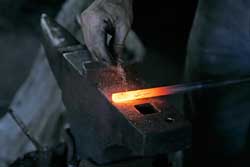Ligurian craftsmanship
The processing of silk originated in the '500 in Fontanabuona and in the Tigullio , in the' 600 the Genoese velvets and damasks were renowned and precious. The textile handicraft of lace and bobbin and macramé lace was born in the 12th century and is still widespread. In the eighteenth century fabrics of Indian origin arrived in Genoa and thus the production of Mezzari was born , large veils with various uses with prints of Persian origin.
 The working of metals with the filigree production of gold and silver of the Genoese Friars reached its maximum splendor, and the working of iron in the valleys between Genoa and Savona was very active, above all thanks to the exploitation of the iron of the Island of Elba. Furthermore, the production of slate with which many objects are made and whose industry requires a considerable artistic sense is also very important.
The working of metals with the filigree production of gold and silver of the Genoese Friars reached its maximum splendor, and the working of iron in the valleys between Genoa and Savona was very active, above all thanks to the exploitation of the iron of the Island of Elba. Furthermore, the production of slate with which many objects are made and whose industry requires a considerable artistic sense is also very important.
Glass, especially in the hinterland of Savona , has always been an important activity in the pre-industrial era and continues, even today, the tradition of artistic glass. In Albisola and Savona , artistic ceramics have been the masters for centuries, and many sculptor artists of the twentieth century have collaborated with the Albisolese masters. It is also important to work with wood, which produces campanine chairs in Chiavari and, in shipbuilding, it is often replaced by modern materials.